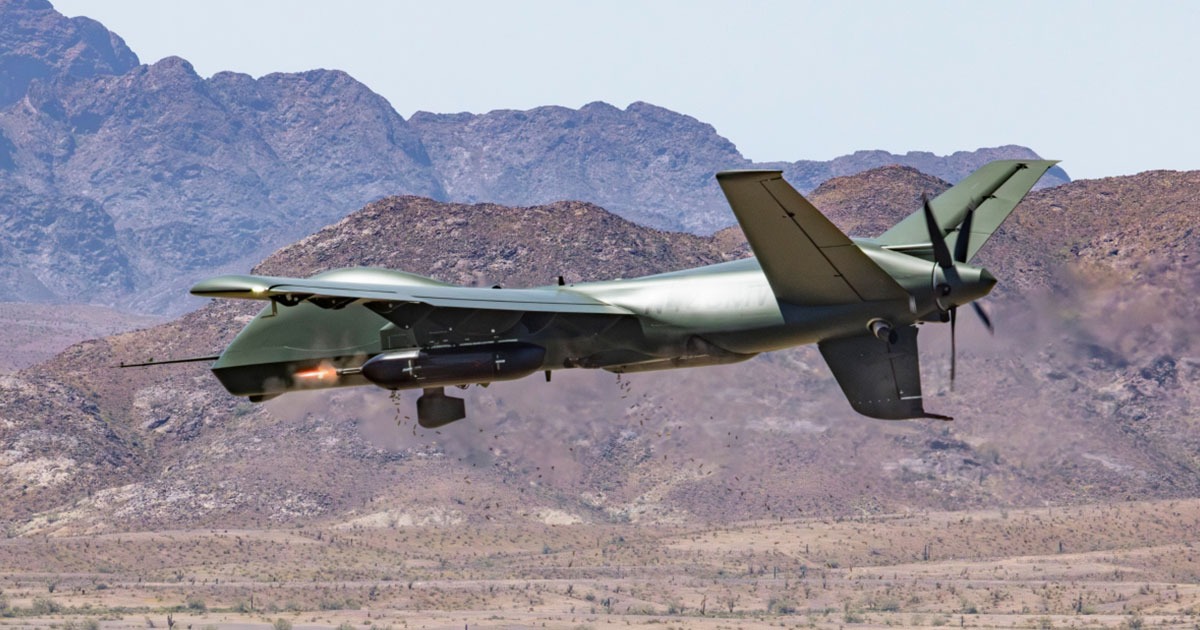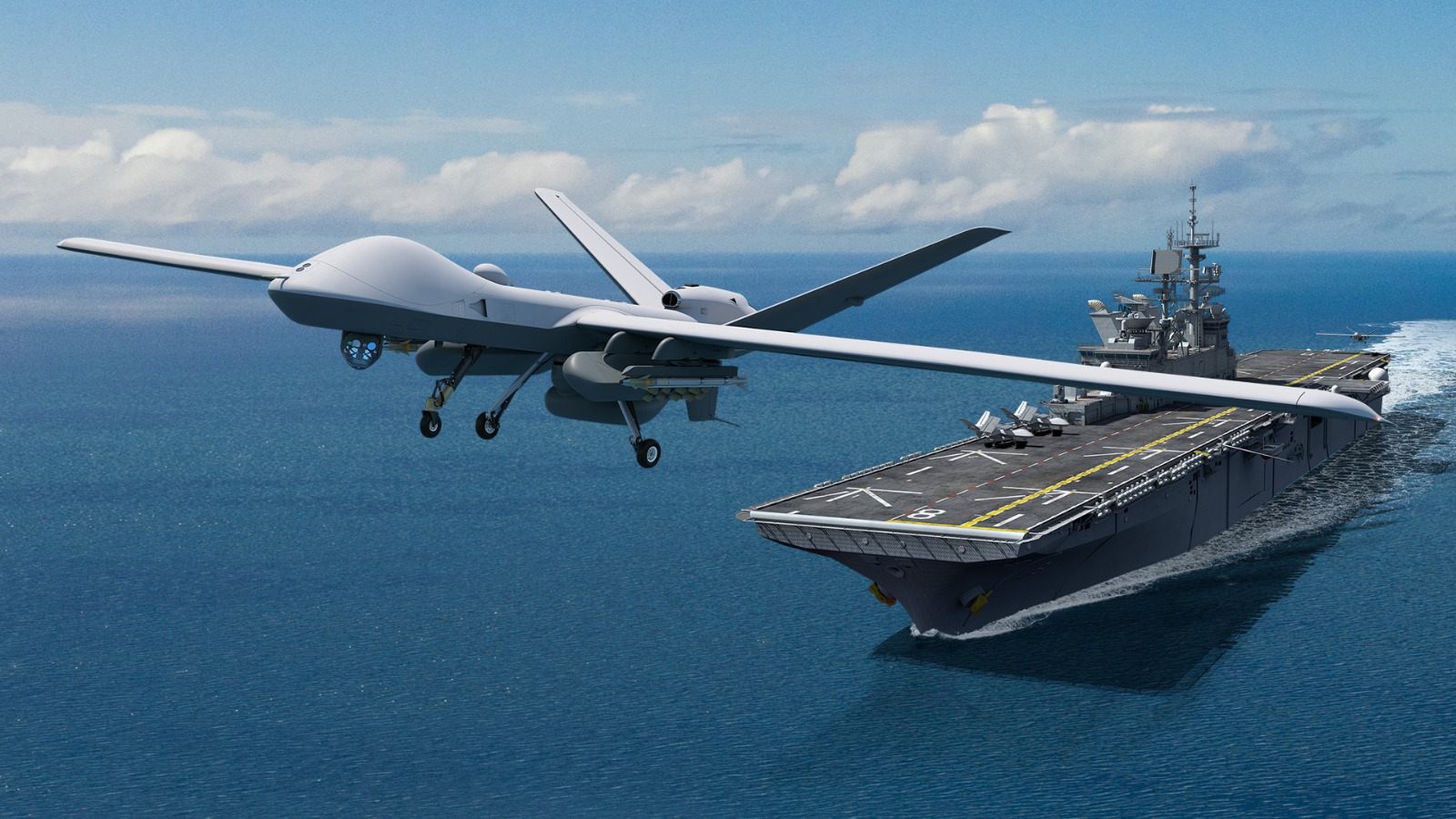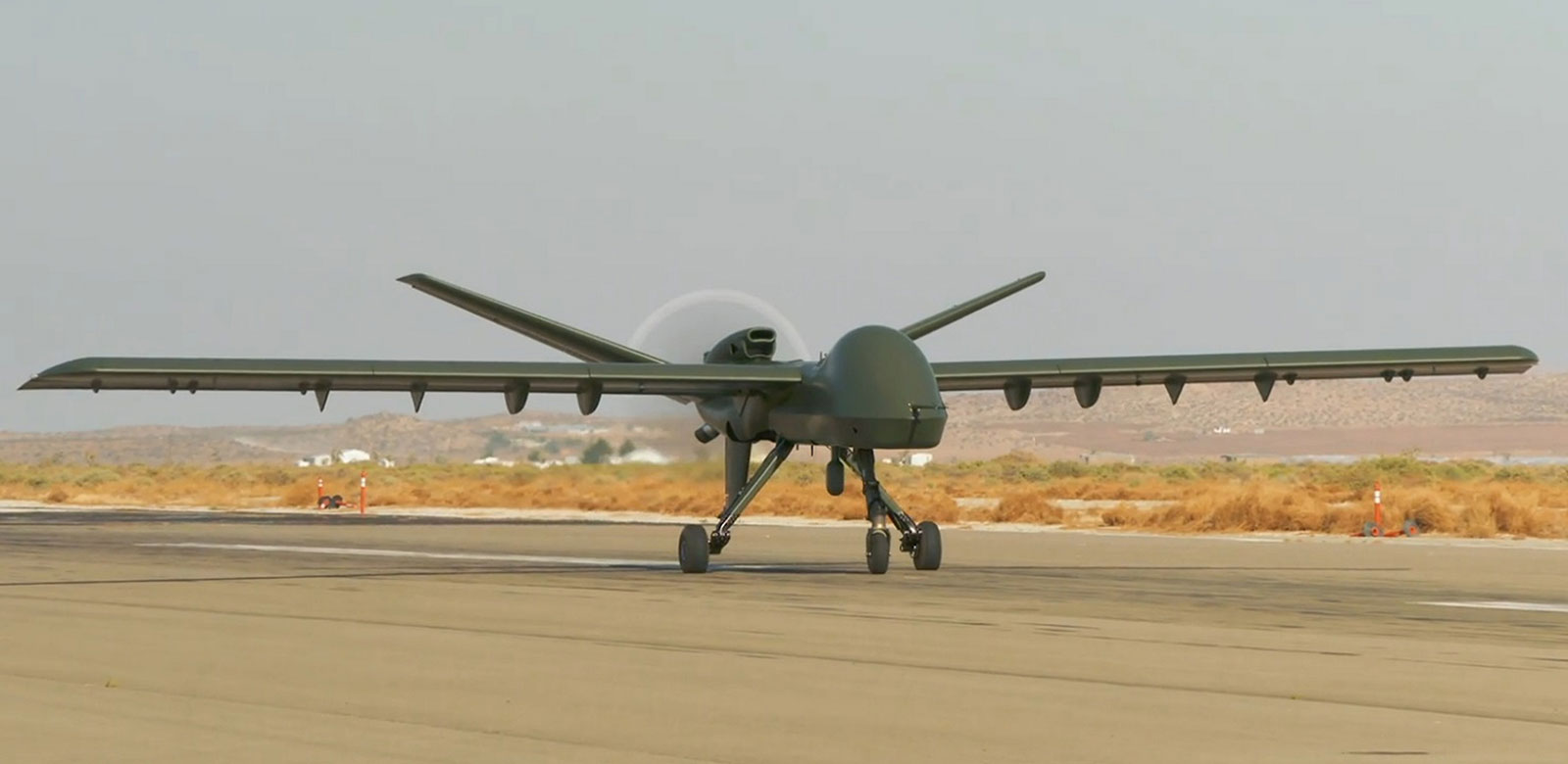In a first-of-its-kind live-fire demonstration conducted this month, General Atomics’ Mojave short take-off and landing drone destroyed multiple targets.
According to a press statement and accompanying video released by General Aeronautical Systems, Inc. (GA-ASI), the DAP-6-armed Mojave engaged various ground targets in seven strafing flights over two consecutive sorties on April 13.
“Seeing our Mojave perform this live-fire demo really emphasizes the versatility of the Mojave UAS and what it can do,” said GA-ASI President David R. Alexander in the statement released 10 days after the test. “Mojave has the ability to act as a sensor, shooter, and sustainer while mitigating threat environments and vulnerabilities and safeguarding human lives.”
The video shows a Chevy pickup truck blowing up at one point. The truck might have been set up with explosives, or the fuel inside could have caught fire, but the 7.62x51mm ammunition that the mini-gun fired was not explosive, according to reports.
All seven passes together accounted for 10,000 rounds of 7.62x51mm ammunition fired, or an average of about 1,428 rounds per pass.
Based on Dillon’s information, the Minigun in a DAP-6 pod can fire 3,000 rounds per minute. Two of the Mojave’s pods could fire at a combined rate of 6,000 rounds per minute during the demonstration. GA-ASI released the first picture of the Mojave with DAP-6 pods under its wings back in 2022.
Mojave, which debuted to the public and had its flight debut in 2021, has three hard points under each wing. Previous images of the drone also show it equipped with AGM-179 Joint Air-to-Ground Missiles (JAGM) and AGM-114 Hellfires. GA-ASI has emphasized that the unmanned aircraft can transport up to 16 Hellfires simultaneously.
Mojave may be equipped with various weaponry, including gun pods similar to the DAP-6. The recent demonstration comes as the manufacturer is pitching the Mojave and the MQ-1C Grey Eagle hybrid to the US Army after the service closed the lid on the Future Attack Reconnaissance Aircraft effort.
Now that work on a manned helicopter has stopped, and the focus has switched to drones, the California-based defense company plans to propose a Gray Eagle STOL, or short takeoff and landing, variant to carry out the armed scout mission.
General Atomics spokesperson C. Mark Brinkley stated earlier this month that a Gray Eagle STOL, which is not yet complete, would expand upon the Mojave demonstrator that the company has used as a “proof of concept” to test features that may be included in future products.
Brinkley also told reporters at that time that the company would demonstrate the Mojave demonstrator to military officials in Denver during the Army Aviation Association of America convention, which would kick off on April 25. The UAV will, incidentally, be on display with two M134 mini guns manufactured by Dillon Aero installed on its wings.
According to Brinkley, the Mojave is being brought to the event to demonstrate the flexibility that an Army-ready STOL Gray Eagle may offer, including its capacity to operate in harsh conditions or aboard ships and to deploy launched effects.

Additionally, there are also plans to demonstrate a resupply pod that the drone can carry, enabling it to transport 1,000 pounds of supplies for operations involving ground replenishment up to 500 kilometers away.
Guns offer an advantage in terms of concentrating fire on smaller targets or groups of smaller targets as compared to even more sophisticated miniature precision-guided bombs and missiles intended to reduce the risk of collateral damage. With a gun, a Mojave would be able to change its target area of focus faster from pass to pass than with precision-guided missiles.
All of this could be especially helpful when close air support is needed in crowded cities or other scenarios where friendly forces or innocent bystanders could be in danger near hostile positions. In addition to its gun and other munitions, the Mojave is also considered suited for operations from austere or distant locations with little logistical support.
What Do We Know About The Mojave?
US defense firm General Atomics unveiled the ‘Mojave’ in 2021. It is a short takeoff and vertical landing (STOVL) aircraft that can take off and land at extremely short distances, landing vertically like a helicopter.
The manufacturer’s goal was for the futuristic drone not to require a runway. The business chose the STOL design after realizing that a vertical takeoff and landing (VTOL) configuration would be too difficult.
The GA-ASI website says, “It is the next step in UAS evolution, delivering unprecedented expeditionary short-takeoff and landing (STOL) performance, C-130 airlift transportability and a significant increase in firepower — without compromising any of the significant advantages in endurance, persistence, or aircrew safety over manned aircraft. Simply put, no aircrew is on board in any danger from the enemy.”

The Mojave can be outfitted with an array of sensors, such as EO/IR, SIGINT, and Synthetic Aperture Radar/Ground Moving Target Indicator (SAR/GMTI), to facilitate land or marine missions.
In November last year, the ‘Mojave’ took off and landed on the deck of the British carrier HMS Prince of Wales off the United States east coast in what was called the first-of-its-kind testing, much like the recent live fire demonstrations.
The nine-meter-long Mojave—with a wingspan of 17 meters and a weight of more than 1.5 tons—became the largest unmanned aircraft ever launched from a British carrier.

Rear Admiral James Parkin, Royal Navy Director Develop, whose team planned the trial, said in a statement, “The Mojave trial is a European first – the first time that a Remotely Piloted Air System of this size has operated to and from an aircraft carrier outside of the United States.”
General Atomics emphasizes that the Mojave has substantial flight endurance, although this depends on increased fuel and added payload, contributing to its weight. Its versatility is evident in accommodating various sensors, including radars with synthetic aperture imaging, signals intelligence suites, communications packages, and a sensor turret under its nose.
With its remarkable capacity to execute successful landings, re-armaments, and takeoffs in challenging locations—especially non-permissive environments—the Mojave surpasses traditional drones in performance. The gun as its armament just enhances that capability.
- Contact the author at sakshi.tiwari9555 (at) gmail.com
- Follow EurAsian Times on Google News




